Our expanding universe: Age, history & other facts
The evolution and content of our ballooning universe
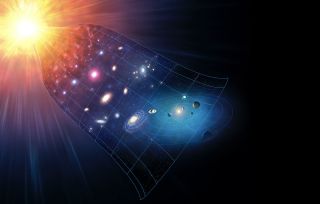
The universe was born with the Big Bang as an unimaginably hot, dense point. When the universe was just 10-34 of a second or so old — that is, a hundredth of a billionth of a trillionth of a trillionth of a second in age — it experienced an incredible burst of expansion known as inflation, in which space itself expanded faster than the speed of light. During this period, the universe doubled in size at least 90 times, going from subatomic-sized to golf-ball-sized almost instantaneously.
The work that goes into understanding the expanding universe comes from a combination of theoretical physics and direct observations by astronomers. However, in some cases astronomers have not been able to see direct evidence — such as the case of gravitational waves associated with the cosmic microwave background, the leftover radiation from the Big Bang. A preliminary announcement about finding these waves in 2014 was quickly retracted, after astronomers found the signal detected could be explained by dust in the Milky Way.
According to NASA, after inflation the growth of the universe continued, but at a slower rate. As space expanded, the universe cooled and matter formed. One second after the Big Bang, the universe was filled with neutrons, protons, electrons, anti-electrons, photons and neutrinos.
During the first three minutes of the universe, the light elements were born during a process known as Big Bang nucleosynthesis. Temperatures cooled from 100 nonillion (1032) Kelvin to 1 billion (109) Kelvin, and protons and neutrons collided to make deuterium, an isotope of hydrogen. Most of the deuterium combined to make helium, and trace amounts of lithium were also generated.
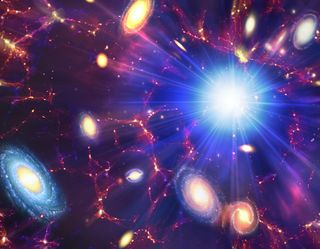
For the first 380,000 years or so, the universe was essentially too hot for light to shine, according to France's National Center of Space Research (Centre National d'Etudes Spatiales, or CNES). The heat of creation smashed atoms together with enough force to break them up into a dense plasma, an opaque soup of protons, neutrons and electrons that scattered light like fog.
Roughly 380,000 years after the Big Bang, matter cooled enough for atoms to form during the era of recombination, resulting in a transparent, electrically neutral gas, according to NASA. This set loose the initial flash of light created during the Big Bang, which is detectable today as cosmic microwave background radiation. However, after this point, the universe was plunged into darkness, since no stars or any other bright objects had formed yet.
About 400 million years after the Big Bang, the universe began to emerge from the cosmic dark ages during the epoch of reionization. During this time, which lasted more than a half-billion years, clumps of gas collapsed enough to form the first stars and galaxies, whose energetic ultraviolet light ionized and destroyed most of the neutral hydrogen.
Although the expansion of the universe gradually slowed down as the matter in the universe pulled on itself via gravity, about 5 or 6 billion years after the Big Bang, according to NASA, a mysterious force now called dark energy began speeding up the expansion of the universe again, a phenomenon that continues today.
A little after 9 billion years after the Big Bang, our solar system was born.
The Big Bang
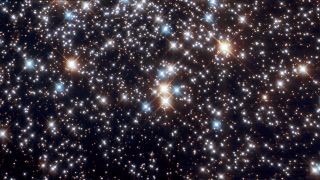
The Big Bang did not occur as an explosion in the usual way one think about such things, despite one might gather from its name. The universe did not expand into space, as space did not exist before the universe, according to NASA. Instead, it is better to think of the Big Bang as the simultaneous appearance of space everywhere in the universe. The universe has not expanded from any one spot since the Big Bang — rather, space itself has been stretching, and carrying matter with it.
Since the universe by its definition encompasses all of space and time as we know it, NASA says it is beyond the model of the Big Bang to say what the universe is expanding into or what gave rise to the Big Bang. Although there are models that speculate about these questions, none of them have made realistically testable predictions as of yet.
In 2014, scientists from the Harvard-Smithsonian Center for Astrophysics announced that they had found a faint signal in the cosmic microwave background that could be the first direct evidence of gravitational waves, themselves considered a "smoking gun" for the Big Bang. The findings were hotly debated, and astronomers soon retracted their results when they realized dust in the Milky Way could explain their findings.
How old is the universe?
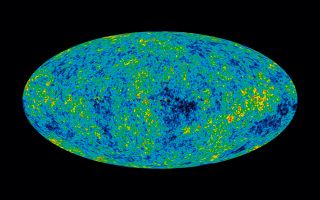
The universe is currently estimated at roughly 13.8 billion years old, give or take 130 million years. In comparison, the solar system is only about 4.6 billion years old.
This estimate came from measuring the composition of matter and energy density in the universe. This allowed researchers to compute how fast the universe expanded in the past. With that knowledge, they could turn the clock back and extrapolate when the Big Bang happened. The time between then and now is the age of the universe.
How is it structured?
Scientists think that in the earliest moments of the universe, there was no structure to it to speak of, with matter and energy distributed nearly uniformly throughout. According to NASA, the gravitational pull of small fluctuations in the density of matter back then gave rise to the vast web-like structure of stars and emptiness seen today. Dense regions pulled in more and more matter through gravity, and the more massive they became, the more matter they could pull in through gravity, forming stars, galaxies and larger structures known as clusters, superclusters, filaments and walls, with "great walls" of thousands of galaxies reaching more than a billion light years in length. Less dense regions did not grow, evolving into area of seemingly empty space called voids.
Contents of the universe
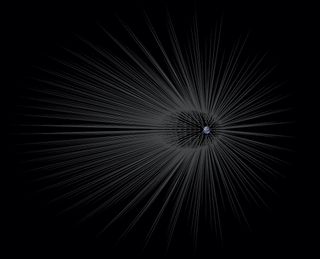
Until a few decades ago, astronomers thought that the universe was composed almost entirely of ordinary atoms, or "baryonic matter," according to NASA. However, recently there has been ever more evidence that suggests most of the ingredients making up the universe come in forms that we cannot see.
It turns out that atoms only make up 4.6 percent of the universe. Of the remainder, 23 percent is made up of dark matter, which is likely composed of one or more species of subatomic particles that interact very weakly with ordinary matter, and 72 percent is made of dark energy, which apparently is driving the accelerating expansion of the universe.
When it comes to the atoms we are familiar with, hydrogen makes up about 75 percent, while helium makes up about 25 percent, with heavier elements making up only a tiny fraction of the universe's atoms, according to NASA.
What shape is it?
The shape of the universe and whether or not it is finite or infinite in extent depends on the struggle between the rate of its expansion and the pull of gravity. The strength of the pull in question depends in part on the density of the matter in the universe.
If the density of the universe exceeds a specific critical value, then the universe is "closed" and "positive curved" like the surface of a sphere. This means light beams that are initially parallel will converge slowly, eventually cross and return back to their starting point, if the universe lasts long enough. If so, according to NASA, the universe is not infinite but has no end, just as the area on the surface of a sphere is not infinite but has no beginning or end to speak of. The universe will eventually stop expanding and start collapsing in on itself, the so-called "Big Crunch."
If the density of the universe is less than this critical density, then the geometry of space is "open" and "negatively curved" like the surface of a saddle. If so, the universe has no bounds, and will expand forever.
If the density of the universe exactly equals the critical density, then the geometry of the universe is "flat" with zero curvature like a sheet of paper, according to NASA. If so, the universe has no bounds and will expand forever, but the rate of expansion will gradually approach zeroafter an infinite amount of time. Recent measurements suggest that the universe is flat with only a 0.4 percent margin of error, according to NASA.
It is possible that the universe has a more complicated shape overall while seeming to possess a different curvature. For instance, the universe could have the shape of a torus, or doughnut.
Expanding universe
In the 1920s, astronomer Edwin Hubble discovered the universe was not static. Rather, it was expanding; a find that revealed the universe was apparently born in a Big Bang.
After that, it was long thought the gravity of matter in the universe was certain to slow the expansion of the universe. Then, in 1998, the Hubble Space Telescope's observations of very distant supernovae revealed that a long time ago, the universe was expanding more slowly than it is today. In other words, the expansion of the universe was not slowing due to gravity, but instead inexplicably was accelerating. The name for the unknown force driving this accelerating expansion is dark energy, and it remains one of the greatest mysteries in science.
Additional resources
Want to explore the universe for yourself? You can roam the Milky Way's stars and galaxies virtually using NASA's Hubble Skymap. Additionally, you can read 10 wild theories about the universe in this article by Live Science.
Bibliography
"The first stars in the Universe". Monthly Notices of the Royal Astronomical Society: Letters, Volume 373, Issue 1 (2006). https://academic.oup.com/mnrasl/article/373/1/L98/989035?login=true
"The molecular universe". Reviews of Modern Physics (2013). https://journals.aps.org/rmp/abstract/10.1103/RevModPhys.85.1021
"Hubble’s Law and the expanding universe". Proceedings of the National Academy of Sciences of the United States of America (2015). https://www.pnas.org/content/112/11/3173.short
Join our Space Forums to keep talking space on the latest missions, night sky and more! And if you have a news tip, correction or comment, let us know at: community@space.com.
Get the Space.com Newsletter
Breaking space news, the latest updates on rocket launches, skywatching events and more!

Charles Q. Choi is a contributing writer for Space.com and Live Science. He covers all things human origins and astronomy as well as physics, animals and general science topics. Charles has a Master of Arts degree from the University of Missouri-Columbia, School of Journalism and a Bachelor of Arts degree from the University of South Florida. Charles has visited every continent on Earth, drinking rancid yak butter tea in Lhasa, snorkeling with sea lions in the Galapagos and even climbing an iceberg in Antarctica. Visit him at http://www.sciwriter.us
